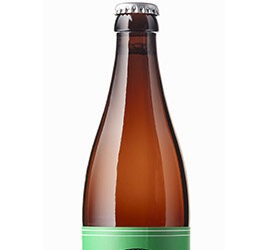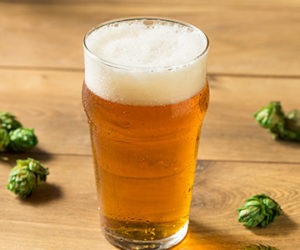Russian River Brewing Co.’s Blind Pig IPA clone
Russian River Brewing Co.’s Blind Pig IPA clone
(5 gallons/19 L, all-grain)
OG = 1.057 FG = 1.009
IBU = 80 SRM = 5 ABV = 6.25%
“My first version of Blind Pig IPA was in 1994 at my very first brewery, Blind Pig Brewing Company, which was located in Temecula, California. This recipe originated from my homebrew days starting in 1989. Years later after Natalie and I took over Russian River Brewing Company from my former employer, Korbel Champagne Cellars, we were able to obtain the trademark for Blind Pig IPA so we brought her back to life.” – Vinnie Cilurzo
Ingredients
11 lbs. (5 kg) 2-row pale malt
10 oz. (283 g) wheat malt
3 oz. (85 g) dextrin malt
13 AAU Chinook hops (60 min.) (1 oz./28 g at 13% alpha acids)
10.5 AAU Centennial hops (15 min.) (1 oz./28 g at 10.5% alpha acids)
3 AAU Cascade hops (15 min.) (0.5 oz./14 g at 6% alpha acids)
0.4 oz. (11 g) Amarillo® hops (whirlpool)
0.75 oz. (21 g) Cascade hops (whirlpool)
0.5 oz. (14 g) Centennial hops (whirlpool)
0.4 oz. (11 g) Crystal hops (whirlpool)
0.8 oz. (22 g) Simcoe® hops (whirlpool)
0.4 oz. (11 g) Amarillo® hops (dry hop)
0.75 oz. (21 g) Amarillo® CGXTM hops (dry hop)
1 oz. (28 g) Centennial hops (dry hop)
0.50 oz. (14 g) Citra® CryoTM hops (dry hop)
0.4 oz. (11 g) Chinook hops (dry hop)
0.7 oz. (20 g) Crystal hops (dry hop)
0.14 oz. (4 g) Nectaron® hops (dry hop)
Wyeast 1056 (American Ale), White Labs WLP001 (California Ale), or SafAle US-05 yeast
¾ cup corn sugar (if priming)
Step by step
Mash the grains at 156 °F (69 °C) for 60 minutes, targeting a mash pH of 5.35–5.45. Conduct a 170 °F (77 °C) mash out step, if desired. Vorlauf until your wort is clear, then run off into the kettle. Sparge the grains with 168 °F (76 °C) water to obtain 6 gallons (23 L) of wort (or more, depending on your evaporation rate).
Boil for 60 minutes following the hopping schedule. After the boil is complete, add the whirlpool hop additions and stir the wort briskly to form a whirlpool, then cover and let stand for 15 minutes. Russian River adjusts the pH in the whirlpool down to 5.0–5.1.
Chill the wort to slightly below fermentation temperature, about 64–66 °F (18–19 °C). Aerate the wort if using a liquid yeast strain, pitch the yeast, and add yeast nutrient if desired. Ferment at 68 °F (20 °C) until final gravity is achieved and let the beer sit for one to two additional days.
If possible, remove yeast from fermenter before adding the dry-hop additions. If able, after three more days, dump the cone of your fermenter to remove as much dry hops and yeast as possible.
Before the dry hop, Vinnie Cilurzo recommends taking a gravity reading of the beer and recording it in your brew log. This exercise will be particularly helpful as it relates to hop creep. Three days after dry hopping, take a gravity reading and note it. Do the same the following day. Once you go two days in a row where your gravity has not dropped from the secondary fermentation from hop creep, you can proceed with chilling the beer and/or bottling or kegging. Depending on your conditions, you might have to wait longer to clear hop creep. Bottle or keg and force carbonate as usual.
Extract version:
Replace the 2-row, dextrin, and wheat malts with 7.3 lbs. (3.3 kg) light liquid malt extract and 8 oz. (230 g) dry wheat malt extract. Add 6.5 gallons (24.5 L) water to your brew kettle and bring to a boil. Remove kettle from heat and carefully stir in the liquid and dry malt extracts until totally dissolved. Return to boil and boil for 60 minutes. Follow the remainder of the all-grain recipe.
Notes from Vinnie:
At our Windsor, California, production brewery we incorporate whole cone hops into the final hop addition. This is done by way of a hop back where the wort runs from our whirlpool, over the whole cone hops in the hop back, and from there the wort gets cooled off and heads to the fermenter.
Over the years the recipe has changed some. In the past there was about 3% crystal malt (40 °L) in the recipe but as you can see, there is now no crystal malt, leaving the beer leaner and thus allowing the hops to pop more.
I look at a beer recipe more as a concept rather than a strict recipe. With that said, over the years some of the hops have changed so you will see some more modern hops in Blind Pig IPA now. Crystal hops are often not thought of as an IPA hop, but it can contribute a nice citrus note to a brew, which I like. In my opinion, this has kept the beer relevant even after all these years.
Finally, feel free to brew this recipe as is, but if you can’t find a particular hop, don’t stress over it. Find something similar and experiment and explore — that is what homebrewing is all about. Also, since this beer is on the lower side of the alcohol range for an IPA, if you like a little more malt body in the beer, I’d suggest removing some of the 2-row malt and replace it with Simpsons Best Pale Ale malt, which will add more malt body to the finished beer.
Written by Vito Delucchi

“My first version of Blind Pig IPA was in 1994 at my very first brewery, Blind Pig Brewing Company, which was located in Temecula, California. This recipe originated from my homebrew days starting in 1989. Years later after Natalie and I took over Russian River Brewing Company from my former employer, Korbel Champagne Cellars, we were able to obtain the trademark for Blind Pig IPA so we brought her back to life.” – Vinnie Cilurzo



